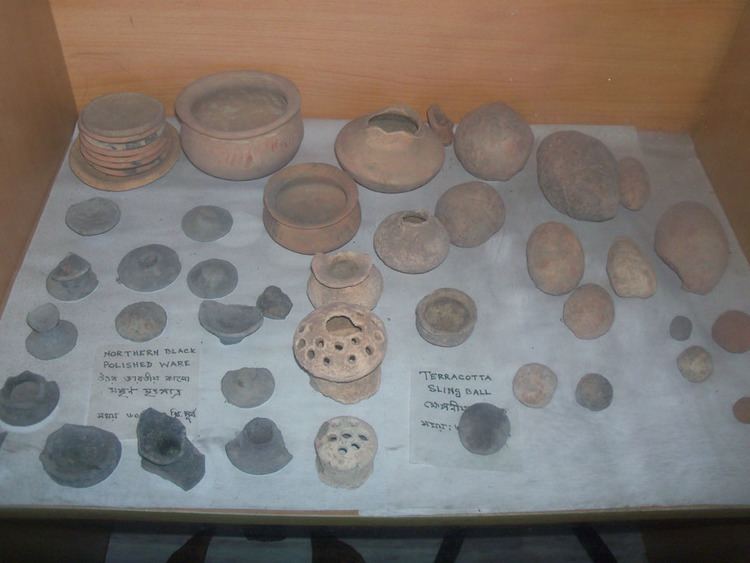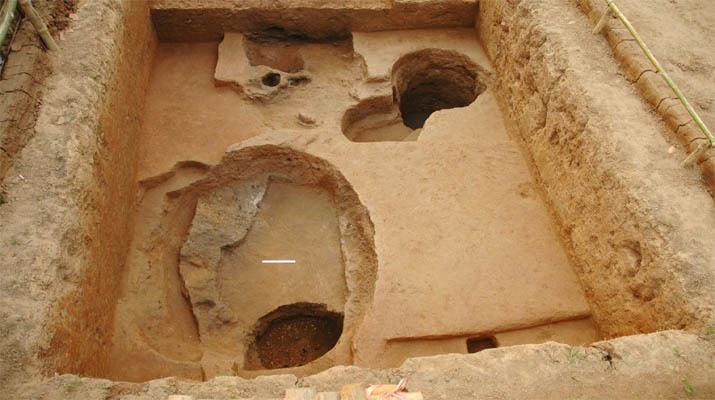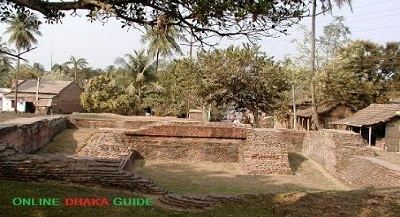 | ||
Wari bateshwar ruins narsingdi
The Wari-Bateshwar region (Bengali: উয়ারী-বটেশ্বর Uari-Bôṭeshshor) in Narsingdi, Bangladesh is the site of an ancient fort city dating back to 450 BC during the era of Maurya dynasty. The 2500-year-old ruins being unearthed near the old course of the Brahmaputra River are a major archaeological discovery in South Asia. It challenges the earlier notions of early urban civilisation in Bengal.
Contents
- Wari bateshwar ruins narsingdi
- Geography
- Wari Bateshwar discovery
- Religious discoveries
- Some other discoveries
- History
- Artefacts
- References

Geography

The site is about 70 km north-east from Dhaka situated at Norshingdi's Belab Upazila and Shivpur Upazila's neighbouring village Wari and Bateshwar
Wari-Bateshwar discovery

In the neighbouring villages of Wari and Bateshwar, many archaeological things were discovered upon digging. In Wari village in 1933, some local diggers found a pot full of ancient coins dating back to 450 BC to 300 BC while digging in the ground of undiscovered Wari-Bateshwar. A local school teacher, Hanif Pathan collected 20–30 of those ancient coins from there. After that, he made his son Habibulla Pathan aware of this incident. In 1955, Bateshwar village, some diggers left behind two ancient metal-made things. Habibulla Pathan shows those things to his father. Then in 1956, during digging in Wari-Bateshwar, an ancient silver coin storage buried underground was discovered. In 1976 Habibulla Pathan collected many archaeological things from Wari-Bateshwar and submitted these things to the Dhaka National Museum. In 2000 under the order of Jahangir Nagar University's archaeologist Professor Sufi Mostafizur Rahman, a digging expedition in Wari-Bateshwar started and many ancient roads, houses, terracotta, silver coins, metal made things, printed currencies, weapons etc. were discovered.
Religious discoveries

About 4 km away from Wari-Bateshwar in Shivpur Upazila in a village named Mondirbhita one Buddhist temple was found. In another village named Jankhartek a big Buddha temple was found which suggests that the residents of Wari-Bateshwar were Buddhists.
Some other discoveries

Nearly 50 ancient archaeological sites have been found around Wari-Bateshwar, with most of the discoveries being settlements. Some of them are known as Rangartek, Sonartula, Kendua, Morjal, Tongirajar Bari, Mondirbhita, Jankhartek, Tongirtek.
History
Prof. Rahman believes that Wari-Bateshwar is the rich, well planned, ancient emporium (a commercial city) "Sounagora" mentioned by Greek geographer, astronomer, mathematician Ptolemy in his book Geographia. The other emporia mentioned in Ptolemy's work include Arikamedu of India, Mantai of Sri Lanka, Kion Thom of Thailand. All of these were the most ancient civilisations in their respective regions, each was a river port, and all of them produced monochrome glass beads. The artefacts found at Wari-Bateshwar bear similarity with those found in the other emporia sites. Mathematician Narayan Chandra Ghosh, though now a resident of Kolkata his birthplace is Satirpara-Narsingdi, visited Wari-Bateshwar on 30 June 2016 to collect detail information about mathematical concepts used there. He has popularised the word 'Folk Mathematics' that he has found at Wari-Bateshwar also. Mathematician Narayan Ch Ghosh, former student of Satirpara K.K. Institution, from Kolkata visited this place on July 2016 for identifying mathematical concepts used there. He has written articles on Wari-Bateshwar in Daily Desher Katha (Published from Agartala), Chalojai published from Kolkata.
Artefacts
According to researchers, the discovery of rouletted ware, knobbed ware, stone beads, sandwiched glass beads, gold-foil glass beads, Indo-Pacific monochrome glass beads and importantly its geographical location indicates to southeast Asiatic and Roman contacts.
Excavation also unearthed the presence of pit-dwelling. The discovery of a pit-dwelling is the first of its kind in Bangladesh. People used to live in these small ditches. The pit-dwelling is a Copper Age or Chalcolithic artefact. Similar pit-dwellings have been found in India and Pakistan which are believed to be 4000 years old. The unearthing of a 180-metre long, six-metre wide and 21–35 cm thick road with a by-lane points to very early urbanisation in this area. Before the discovery of this, the widely held view was that urbanisation occurred later than the Wari-Bateshwar ruins indicate.
Silver punch-marked coins, different types of earthen pots, rouletted ware, knobbed ware, northern black polished ware, black-slipped ware, common ceramics, semi-precious stone beads. Iron artefacts include blooms, hand-axes, spearheads, knives, nails and slugs, melted pieces of iron. It is also suspected that it might be the oldest place in the world which have a money based currency system.
